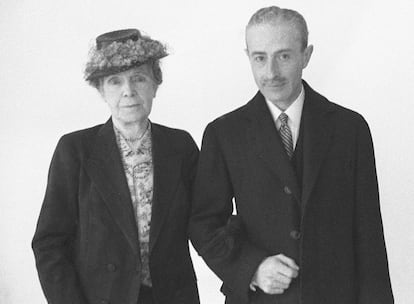
Eulalia de Borbón y Borbón has been an uncomfortable presence for her family since the day she was born. On February 12, 1864, the Spanish hoped that Isabella II would give birth to a son to ensure the continuity of the dynasty, but she arrived instead. While the girl was presented on a silver platter to the ambassadors and members of the court, her mother, the queen, listened to the Madrid people’s cries of discontent because the child was an infanta. The sex of the newborn, the king’s seventh daughter, was also used as a political weapon by General Prim and the Duke of Montpensier, great conspirators during the Elizabethan reign.
The revolution of 1868 pushed the royal family into exile in Napoleon III’s imperial France. Without the throne, Isabella II and Francisco de Asís de Borbón separated. The queen and her children settled in the Palace of Castile, on the Parisian Avenue Kléber, while Francis opted for a more discreet and simple life under the incognito title of Count of Moratalla.
Exile gave Eulalia the opportunity to live a happy and carefree childhood, far from the palace intrigues of Madrid. But his days of happiness were numbered. The restoration of the monarchy, in 1874, condemned her to return to Spain. Her brother Alfonso XII, the new king, had plans for her: she should marry her cousin, Anthony de Orleans, son of the Duke of Montpensier, to ensure the stability of the restored monarchy.
It didn’t take long for the marriage of convenience to fail. At 22, newly married, she discovered that her husband had several mistresses, the most notable of whom was Carmen Giménez Flores. Antonio de Orleans began to squander his wife’s fortune on his mistresses. «My husband, in just six years, had squandered the fabulous sum of almost 50 million francs in carousing, affairs and adventures», the infanta confessed in her memoirs, published many years later.
The end of the century encouraged her. In 1900, after 14 years of marriage and two children together, she filed for divorce and left the marital home. “An hour after my conversation with Antonio, I settled in my mother’s house, ready to face everything: Spanish public opinion, the anger of my family, the slander, the lawsuits, whatever came, but which I considered necessary to save my children from ruin”, she will remember. The conventions of the time prohibited a Catholic queen from receiving a separated woman, but Isabella II used to see her first cousins, Infanta Isabel, married and separated from Count Gurowski, and Infanta Josefa, Aunt Pepita, separated from Count Güell and Rente. She herself had been extrajudicially separated from her husband since leaving Spain.

But Eulalia de Borbón wanted to go further than all her predecessors. She requested legal separation, which Antonio de Orleans refused. Isabella II’s daughter threatened to go to court to “claim as a Spaniard what had been denied to me as an infanta.” Manuel García Prieto, former minister of Alfonso XII, assumed the defense of the prince. He represented the Infanta Trinitario Capdepón, minister during the regency of Queen María Cristina. The dispute became a topic of city conversation and a headache for the Bourbons.
While the Orléans family took Eulalia’s side, the Bourbons, angered by her disobedience, tried to dominate her out of fear. “The royal family did not take kindly to the fact that an infanta was the cause of murmurs, of comments, of being targeted, and it was feared that her attitude could serve as an example to other women at court,” she will write. “In Spain, a marital separation constituted a scandal, something that made honest ladies’ hair stand on end and they made crosses. In France, however, what in my land shouted to the heavens seemed natural.”
The “rebel” infanta broke with Spain. For five years he almost never set foot in Madrid and dedicated himself to traveling to the European courts. After several years of litigation, she managed to convince her husband to sign a separation certificate at the Spanish consulate in Paris. She recovered her money and her unmarried status and became the first divorced woman in the Spanish royal family, a century before Infanta Elena, who separated from Jaime de Marichalar in 2009.
After the coronation of his nephew Alfonso XIII, in 1902, he returned to frequent the Spanish court. She was surprised by the intellectual poverty of the Alphonsian aristocracy. “The nobles built a wall between the monarchy and the intellectuals, and both were first strangers and then enemies. For a Duke of Alba determined to contribute his social prestige, his money and his talent to the cultural progress of the country, there were 100 other grandees of Spain far from all this, angry at the socialists and unable to distinguish between a Benavente and a Baroja,” he observes. She, however, was friends with Republicans like Rafael Altamira.
He was in Lisbon, visiting his niece, Amelia of Orleans, when the Portuguese Revolution broke out, overthrowing King Manuel of Portugal, in 1910. When he returned to Madrid, he met his nephew and advised him to make reforms. “Republican! Whenever something was said at the Spanish court that deviated from the predominant criteria, or was expressed freely, or exposed reality, the word was born as a nickname. Not being blinded, not having a blindfold or a gag in the mouth, meant being a republican. Republican! For many Spanish nobles I was. It was all of us who were not determined not to see”, the Infanta Eulalia then underlined. And he predicted: “If the Republic ever comes here, it will not be for Altamira, nor for the books of Galdós, you can be sure of that. No, it will be for some monarchists. There is every one of them who, by the mere fact of being one, is a republican proclamation.”
In 1911 he published At the edge of lifea series of unpretentious literary observations in which he predicted the end of many European monarchies, lamented Spain’s cultural backwardness, and called for the emancipation of women and equality between men and women. “The 20th century will not continue to be a quiet extension of the previous one,” he said. “My book did not aspire to be anything other than an index of the paths taken by society and its only merit was that of being somewhat prophetic”. The court defined it as immoral and scandalous, an attack on religion, the monarchy, good morals and the established order. No one had read it yet, but there was no need. It was a work by Eulalia de Borbón and, therefore, republican. As in Fernandine’s time, Alfonso XIII issued a royal order against his aunt prohibiting her from entering Spain.

He spent years wandering around Europe, from court to court: Germany, England, Holland. In the summer of 1921, after 11 years of exile, he found his nephew again in Deuville. “When will you return to Spain? You already know that we will be happy to have you back with us. All this was a nonsense of which neither you nor I are to blame”, the king told him. “You know, I’ve kind of lost the habit of going to Spain, and also the desire, don’t believe it. I have nothing to look for in Madrid,” he replied. José Quiñones de León, the Spanish ambassador in Paris, had to intervene to convince her to return.
His return to Spain was bitter. She was struck by the situation the country found itself in in 1922, in the midst of the Moroccan war and on the brink of the dictatorship of Miguel Primo de Rivera. “The great Spanish people, the provincial nobles, the bourgeois, the bosses, the workers and the military were dissatisfied with the situation. In general, they were all against the politicians, Spain was already tired of lobbyism, of traditional despotism, of the politics that the men of ’68 had left us”, he evoked regarding that visit.
In 1925 he visited the Escorial with some English friends and saw the guides telling tourists that after Alfonso XIII there would be no place to bury any more kings, but that it didn’t matter because after Alfonso XIII would come the Republic. He told it to his nephew, who didn’t give it much importance.
Eulalia de Borbón left Spain in 1930 feeling that the monarchy’s days were numbered. The proclamation of the Second Republic, on April 14, 1931, surprised her in Paris. Some time later he began to write Memoirs of Doña Eulalia de Borbónwhich were published in April 1935 —90 years before the controversial biography of Juan Carlos I—, during the presidency of Alcalá-Zamora. The last pages are dedicated to the revolution. In them he praises the civility with which the Spanish people dethroned the Bourbons: “Unlike what happened in other countries in similar circumstances, not a shot was heard, not a nobleman was attacked, not an insult or a repugnant cry was heard from the Royal Family, who crossed the entire peninsula to reach the French border”.
Alfonso XIII was never able to return to Spain. The king died in Rome in 1941. The aunt, however, lived her last years in a villa in Irun. After the civil war, Franco allowed him to return to the countryside and gave him a car and driver for life. Even then, Infanta Eulalia was a legend. He had lived through the reigns of Isabella II, Alfonso XII, the Regency and Alfonso XIII, had met five pontiffs and had seen 15 European thrones fall. A young Juan Carlos de Borbón visited her from time to time. The Princess died on 8 March 1958, aged 96. His funeral was celebrated in El Escorial with great pomp. A few months later, in July, Editoriale Juventud republished his memoirs. In them he states: “God made me Spanish and as such I feel and wait and will live until the end of my days”.





